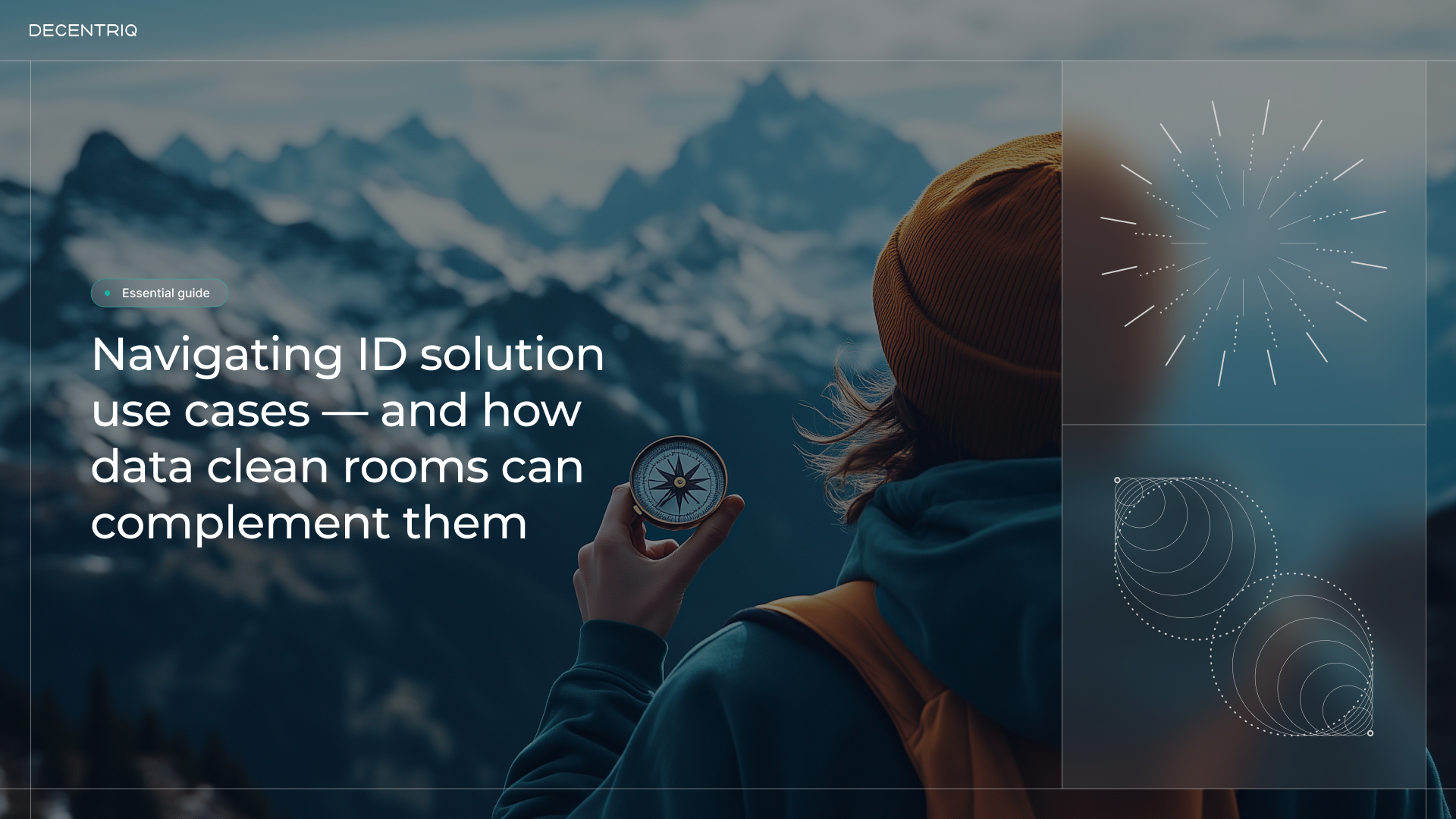Why ID solutions aren’t a one-size-fits-all fix if you're leaving third-party data behind

How data clean rooms can enhance ID solutions
As third-party data declines, advertisers are turning to identity (ID) solutions to maintain audience targeting — or have already adopted them. It’s no surprise why: Major digital ad players back them, creating a strong ecosystem and seamless integration into existing workflows. However, ID solutions alone don’t fill all the gaps left by weak third-party data. Read our guide to learn what’s missing, how data clean rooms can help, and how to quickly implement an ID solution if you haven’t yet.

With third-party data continuing to decay, many advertisers are exploring identity (ID) solutions as a next step or have already implemented them to continue optimally targeting their audiences. And it’s easy to understand why: They’re supported by the big names in digital advertising, which creates a robust ecosystem and makes them easy to implement into existing workflows.
Still, ID solutions aren’t a one-stop shop for all of the holes poor third-party data leaves unfilled. Read on to discover what gaps they leave, how you can fill these with data clean rooms and — if you don’t already have an ID solution in place — how you can fast-track getting one.

ID solutions and data clean rooms: Individually strong, a powerhouse when used together
Both data clean rooms and ID solutions aim to provide advertisers with the means to target, measure, and optimize their campaigns without using third-party cookies. However, they each have distinct strengths and use cases that make them valuable in different ways. These are detailed in the subsections below.
Use cases: Where each solution shines
ID solutions
Before we go any further, it’s necessary at this point to define the two types of identifiers that ID solutions can be based on, as these vary in their abilities.
Deterministic identifiers have a 1:1 correlation with some identifying property of the user, like an email address or telephone number.
Probabilistic identifiers take different signals in the form of data points and use probability to determine whether these data points are related and belong to the same person. Obviously, this is much less certain than the deterministic variation.
There is also a third type of identifier, which is a hybrid of the two kinds described above.
Now, on to what ID solutions can do best (and how this differs depending on the type of identifier):
- Retargeting web visitors: In this use case, a user visits an advertiser website, and — whether logged in or not — then gets exposed to an ad from the advertiser when visiting a publisher website (once again, logged in or not). Some deterministic ID solutions support this, depending on what identifiers they use. Solutions based on probabilistic identifiers are suitable for this use case as well, but with lower accuracy than deterministic IDs.
- Remarketing to existing customers: Here, an advertiser assigns an ID to an existing user, typically sitting in their CRM, and exposes them to an ad when they visit a publisher website. Because ID solutions identify users across various touchpoints, they are well-suited to help deliver personalized ads based on previous interactions. Understandably, deterministic ID solutions can better support this than probabilistic ones, since they don’t rely on the data points left at those previous interactions like name or address. The limitation with this approach is that users need to be logged in onto the publisher website to be assigned the ID, meaning the reach provided is rather low.
- Cross-publisher frequency capping: ID solutions help ensure your audience doesn’t get overwhelmed by being exposed to the same ad repeatedly. This is the case even when they move across different publishers while browsing the web.
If you’re thinking that these use cases won’t replace what you used to be able to do with third-party cookies, you’d be right. But data clean rooms offer a way to fill those gaps. And in most cases, implementing them is much faster and lighter-touch than an ID solution. The next section outlines what data clean rooms can do in more detail.
Data clean rooms
- Audience insights: When you collaborate in a data clean room, you’ll have the ability to see where your audience overlaps with a publisher’s. This way, you can uncover new customer attributes, segments, and demographic insights and use them to improve campaign planning.
- Lookalike targeting: By analyzing the traits of your existing customers, data clean rooms help you find and target new customers in the publisher’s audience who share similar characteristics.
- Measurement: Data clean rooms enable several different types of measurement. When it comes to on-target measurement, they allow advertisers to determine the effectiveness of their campaigns more accurately by securely uploading data into a clean room for analysis by third-party vendors. Clean rooms built on the strictest privacy standards will ensure that the third party is unable to view or access the raw data during the analysis process. At the same time, clean rooms also let marketers measure conversion. Tracking conversions and attributing them to specific campaigns is crucial for understanding ROI. Data clean rooms provide a secure environment for matching your campaign data with conversion data to better evaluate and optimize your campaign effectiveness.
- Audience enrichment with second- or third-party data providers: Through the integration of additional data sources, data clean rooms provide a more comprehensive understanding of your audience so that you can target even more precisely.
Acquisition and implementation: ID solutions vs data clean rooms
When getting these solutions up and running, there are some notable differences:
ID solutions:
- Extensive setup: Implementing an ID solution can be a lengthy process. It often requires extensive legal and compliance approval cycles, leading to long setup times.
- High-commitment contracts: These solutions typically come with deeper contract commitments because of how thoroughly they need to be integrated into your tech stack. This then makes it harder to pivot and change strategies or providers if the specific ID solution isn’t working out for your organization.
Data clean rooms:
- Quick and easy setup: Data clean rooms — especially ones with extremely strict privacy guarantees around data access — offer a streamlined setup process. You can get started quickly without the extensive approval and integration hurdles that come with ID solutions.
- Flexible use: Some data clean rooms, like Decentriq, allow you to use ID solutions in a much faster, more secure, and less committed way. For example, by simply uploading your customer email addresses to a Decentriq clean room, you can retrieve corresponding universal IDs without fully onboarding an ID solution onto your website.
In Switzerland, we enable advertisers easy access to OneID by connecting their CRM to Decentriq. They can use OneID when they run campaigns, but they don’t need to install it on their website.
- Complementary to ID solutions: If you already have an ID solution in place, a data clean room can still be used alongside it for maximally effective cookieless ads.
The bottom line
ID solutions are not a 1:1 replacement for third-party cookies: While they offer valuable features, ID solutions leave some gaps. Data clean rooms are optimal for filling these and ensuring comprehensive targeting, measurement, and optimization.
Some data clean rooms offer a “fast lane” to ID solutions: Data clean room providers like Decentriq who have partnerships with ID solution providers make it easier and faster to use the benefits of ID solutions without the commitment or long setup time. By providing a streamlined, secure approach, they let you get the most out of both technologies.
Ready to take your post-cookie marketing to the next level? Contact us to discover how ID solutions and data clean rooms can transform your advertising strategy. Let's make your campaigns more effective and privacy-compliant in this new era!
References
How data clean rooms can enhance ID solutions
As third-party data declines, advertisers are turning to identity (ID) solutions to maintain audience targeting — or have already adopted them. It’s no surprise why: Major digital ad players back them, creating a strong ecosystem and seamless integration into existing workflows. However, ID solutions alone don’t fill all the gaps left by weak third-party data. Read our guide to learn what’s missing, how data clean rooms can help, and how to quickly implement an ID solution if you haven’t yet.

Related content
Subscribe to Decentriq
Stay connected with Decentriq. Receive email notifications about industry news and product updates.




.jpg)